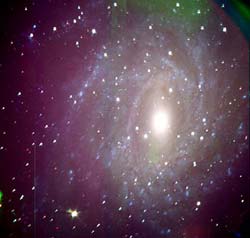‘First Light’ For Africa’s Giant Eye

NGC 6744 is a large face-on barred spiral galaxy in the star-rich southern constellation of Pavo. It lies at a distance of approximately 30 million light years, and spans almost 150 000 light years in diameter. NGC 6744 is often considered one of the most Milky Way-like galaxies known.
Astronomers and students at UK universities and observatories can use their PCs to spot stars as faint as a candle on the Moon using a record-breaking new telescope.
The Southern African Large Telescope (SALT), the largest in the southern hemisphere and equal to the largest in the world, was built by partners in six countries including a UK consortium consisting of Armagh Observatory, the University of Keele, the University of Central Lancashire, the University of Nottingham, the Open University and the University of Southampton.
The £11 million SALT project has now released its first colour images from space, five years after construction started. The UK associates, along with partners in Germany, Poland, New Zealand, South Africa and the USA, have been amazed at the quality of the images, which are the first taken by SALT’s new $600,000 digital camera, SALTICAM.
The ‘first light’ sample images were shot during the camera’s first trial period of operation, which also achieved SALT’s first significant scientific results.
Professor Gordon Bromage, Chairman of the UK SALT Consortium said: “The declaration of first light signifies that SALT has arrived on the astronomical scene. Astronomers within the SALT consortium keenly look forward to the scientific fruits of what has been an extremely successful engineering project.
“SALT is truly representative of this century. Not only is it a sophisticated computer controlled precision instrument, but it is also an Internet-age telescope. No longer will it be necessary for astronomers to travel to South Africa to use it. Instead they will submit their observing requests and receive the resulting data over the Internet. In many respects this makes SALT far more like a space-based telescope, like the Hubble Space Telescope.”
Dr. Phil Charles, Director of SALT said: “I am delighted with these First Light images and results that demonstrate the level of operation we have already attained. Of course, we expect these capabilities to improve further as the final construction work is completed and commissioned (particularly the mirror’s edge sensors that maintain the mirror “shape”). To have achieved this within 5 years of the groundbreaking ceremony is a splendid testament to the efforts of the entire SALT Project Team, and I give my hearty congratulations to the Project Manager and Project Scientist, who have set a benchmark for the entire international community. We look forward with great anticipation to the first year of SALT science operations.”
Limited scientific observations have already begun while completion of the telescope’s commissioning continues over the coming months. In the near future installation will begin of the major first generation instrument, the Prime Focus Imaging Spectrograph. SALT science programmes will vary from studies of the most distant and faint galaxies to observations of asteroids and comets in our own solar system. The facility has been completed on time and in budget.
South African President Thabo Mbeki will officially open SALT on 10 November 2005.
Media Contact
More Information:
http://www.uclan.ac.uk/news/2005/web106.htmAll latest news from the category: Physics and Astronomy
This area deals with the fundamental laws and building blocks of nature and how they interact, the properties and the behavior of matter, and research into space and time and their structures.
innovations-report provides in-depth reports and articles on subjects such as astrophysics, laser technologies, nuclear, quantum, particle and solid-state physics, nanotechnologies, planetary research and findings (Mars, Venus) and developments related to the Hubble Telescope.
Newest articles

Silicon Carbide Innovation Alliance to drive industrial-scale semiconductor work
Known for its ability to withstand extreme environments and high voltages, silicon carbide (SiC) is a semiconducting material made up of silicon and carbon atoms arranged into crystals that is…

New SPECT/CT technique shows impressive biomarker identification
…offers increased access for prostate cancer patients. A novel SPECT/CT acquisition method can accurately detect radiopharmaceutical biodistribution in a convenient manner for prostate cancer patients, opening the door for more…

How 3D printers can give robots a soft touch
Soft skin coverings and touch sensors have emerged as a promising feature for robots that are both safer and more intuitive for human interaction, but they are expensive and difficult…





















